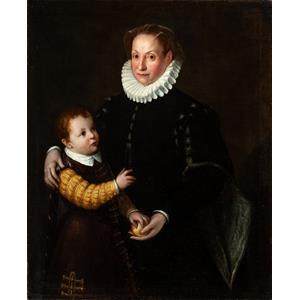DÉTAILS DE L'IMAGE

Nicolás Cortés Gallery
Lavinia Fontana (Bologna 1552–1614 Rome)
Portrait of a Noblewoman and a Child, 1604-1614
Oil on unlined canvas
112.5 x 92.5 cm
Provenance: Spinola family, Castello di Pasturana, Piedmont (19th century); sold to Emilia Balduino on 13 June 1933; by descent to the present owner
According to Maria Teresa Cantaro, the present painting is a characteristic work by the Bolognese artist Lavinia Fontana and stands out for its delicate drawing, softly nuanced colours, and accomplished interplay between light and dark areas. The artist particularly concentrated on the rendering of textures, ornaments, and complexions, which underscores her love of detail.
A woman in a high-necked, dark-coloured dress is rendered against a dark backdrop. The hair is combed back from her face so that her brow is revealed, while her head is covered by a widow’s veil. With her right arm she embraces the young boy standing next to her, who is about to reach out for an apple she holds in her left hand. The apple may symbolically allude to the fact that now, after his father’s death, the boy will succeed him as the heir of a dynasty. The mother, still holding the apple, functions as an intermediary who will head the family until her son has come of age. The veil and the lack of jewellery symbolise her grief over the loss of her husband.
The subject of widowhood is known from other compositions by Lavinia Fontana, such as from the Portrait of Flaminia Gozzadini Caccianemici (private collection, Vidor), which is dated to the first years of the 17th century, and the Portrait of a Woman (Collezione d’Arte e di Documentazione Storica della Cassa di Risparmio, Bologna). In both paintings, the sitter wears a widow’s veil. Murphy (see C. P. Murphy, Lavinia Fontana. A Painter and Her Patrons in Sixteenth-Century Bologna, New Haven & London 2002, p. 137) has pointed out that the
painting Portrait of a Noble Lady and Child (Pinacoteca Nazionale, Bologna, preserved at Palazzo Pepoli), which can be dated to around 1595, shows the sitter with the protective gesture of putting her arm around the child’s shoulder which is indeed similar to the present painting.



 TÉLÉCHARGER L'IMAGE
TÉLÉCHARGER L'IMAGE